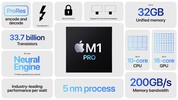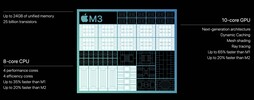Apple M1 Pro 16-Core GPU vs Apple M3 Pro 14-Core GPU vs Apple M3 8-Core GPU
Apple M1 Pro 16-Core GPU
► remove from comparison
The Apple M1 Pro 16-Core-GPU is an integrated graphics card by Apple offering all 16 cores in the M1 Pro Chip. The 2048 ALUs offer a theoretical performance of up to 5.3 Teraflops.
The graphics card has no dedicated graphics memory but can use the fast LPDDR5-6400 unified memory with a 256 bit bus (up to 200 GBit/s).
The GPU clocks between 389 and 1296 MHz and offers no short term boost (389, 486, 648, 778, 972, 1296 MHz steps according to Powermetrics). The GPU is intended to use Apple Metal 2 API and could still be based on the older PowerVR architectures (last used in the Apple A10).
The Apple M1 Pro is manufactured in the modern 5nm process at TSMC and offers an excellent energy efficiency. According to the internal sensors, the GPU uses 15 Watt (Valley) to 20.6 W (Eve Online) under full load.
Apple M3 Pro 14-Core GPU
► remove from comparison
The Apple M3 Pro 14-Core GPU is a self-designed graphics card in the Apple M3 Pro (with 11 CPU cores) and offers fourteen of the eighteen cores available on the chip. The graphics card uses a new architecture and now offers dynamic caching, mesh shading and ray tracing acceleration.
The GPU can access up to 24 GB LPDDR5-6400 unified memory via a 192-bit memory bus (max 150 GBit/s). Thanks to dynamic caching, the GPU only reserves as much memory as is required.
The entire chip is manufactured in the current 3nm process (probably N3B) at TSMC.
Apple M3 8-Core GPU
► remove from comparison
The Apple M3 GPU is an integrated graphics card offering 10 cores designed by Apple and integrated in the Apple M3 SoC. It uses the unified memory architecture of the M3 SoC (up to 24 GB LPDDR5-6400 with 100 GB/s bandwidth). The GPU uses a new architecture with support for mesh shading and ray tracing. Dynamic caching is also a new feature that should only us as much shared memory as needed.
The old M2 SoC showed a difference of around 15% between the 8-core and 10-core variant. Therefore, we expect a similar difference for the M3 models. This means, the M3 8-core version should be slightly faster than the 10-core GPU in the Apple M2.
The M3 chip is manufactured in the new 3nm process at TSMC (most likely N3B). The power limit should be around the same 15 Watt as the 10-core variant.
| Apple M1 Pro 16-Core GPU | Apple M3 Pro 14-Core GPU | Apple M3 8-Core GPU | |||||||||||||||||||||||||||||||||||||||||||||||||||||||||||||
| Apple M3 Series |
|
|
| ||||||||||||||||||||||||||||||||||||||||||||||||||||||||||||
| Pipelines | 16 - unified | 14 - unified | 8 - unified | ||||||||||||||||||||||||||||||||||||||||||||||||||||||||||||
| Core Speed | 1296 MHz | ||||||||||||||||||||||||||||||||||||||||||||||||||||||||||||||
| Memory Type | LPDDR5-6400 | LPDDR5-6400 | LPDDR5-6400 | ||||||||||||||||||||||||||||||||||||||||||||||||||||||||||||
| Shared Memory | no | no | no | ||||||||||||||||||||||||||||||||||||||||||||||||||||||||||||
| Power Consumption | 10 Watt | 15 Watt | |||||||||||||||||||||||||||||||||||||||||||||||||||||||||||||
| technology | 5 nm | 5 nm | 5 nm | ||||||||||||||||||||||||||||||||||||||||||||||||||||||||||||
| Date of Announcement | 10.11.2020 | 31.10.2023 | 31.10.2023 | ||||||||||||||||||||||||||||||||||||||||||||||||||||||||||||
| Notebook Size | medium sized | ||||||||||||||||||||||||||||||||||||||||||||||||||||||||||||||
| Predecessor | M1 8-Core GPU |
|
| |||||||||||||||||
Benchmarks
Cinebench R15 OpenGL 64 Bit + Apple M1 Pro 16-Core GPU
GFXBench T-Rex HD Offscreen C24Z16 + Apple M1 Pro 16-Core GPU
Average Benchmarks Apple M1 Pro 16-Core GPU → 100% n=5
Average Benchmarks Apple M3 Pro 14-Core GPU → 109% n=5
Average Benchmarks Apple M3 8-Core GPU → 63% n=5
* Smaller numbers mean a higher performance
1 This benchmark is not used for the average calculation
Game Benchmarks
The following benchmarks stem from our benchmarks of review laptops. The performance depends on the used graphics memory, clock rate, processor, system settings, drivers, and operating systems. So the results don't have to be representative for all laptops with this GPU. For detailed information on the benchmark results, click on the fps number.

Total War Pharaoh
2023
Baldur's Gate 3
2023
Borderlands 3
2019
Civilization 6
2016
The Witcher 3
2015Average Gaming Apple M1 Pro 16-Core GPU → 100%
Average Gaming 30-70 fps → 100%
Average Gaming Apple M3 Pro 14-Core GPU → 108%
Average Gaming 30-70 fps → 108%
| Apple M1 Pro 16-Core GPU | Apple M3 Pro 14-Core GPU | Apple M3 8-Core GPU | |||||||||||||||||||
|---|---|---|---|---|---|---|---|---|---|---|---|---|---|---|---|---|---|---|---|---|---|
| low | med. | high | ultra | QHD | 4K | low | med. | high | ultra | QHD | 4K | low | med. | high | ultra | QHD | 4K | ||||
| Total War Pharaoh | 193 | 125 | 67 | 53 | 35 | ||||||||||||||||
| Baldur's Gate 3 | 42 | 39 | |||||||||||||||||||
| Total War: Three Kingdoms | 114 | 69.6 | 43.8 | 31.8 | 75 | 49.5 | 35.9 | 22.5 | |||||||||||||
| Shadow of the Tomb Raider | 63 | 57 | 50 | 66 | 60 | 53 | 34 | ||||||||||||||
| The Witcher 3 | 39 | ||||||||||||||||||||
| GTA V | 79 | 50 | |||||||||||||||||||
| Apple M1 Pro 16-Core GPU | Apple M3 Pro 14-Core GPU | Apple M3 8-Core GPU | |||||||||||||||||||
| low | med. | high | ultra | QHD | 4K | low | med. | high | ultra | QHD | 4K | low | med. | high | ultra | QHD | 4K | < 30 fps < 60 fps < 120 fps ≥ 120 fps | 1 | 2 | 2 | 2 | | | < 30 fps < 60 fps < 120 fps ≥ 120 fps | 1 | 2 1 | 2 3 | 6 | 1 2 | | < 30 fps < 60 fps < 120 fps ≥ 120 fps | | | | | | |
For more games that might be playable and a list of all games and graphics cards visit our Gaming List















